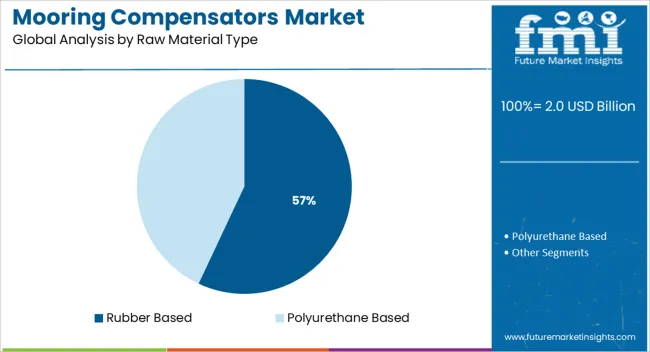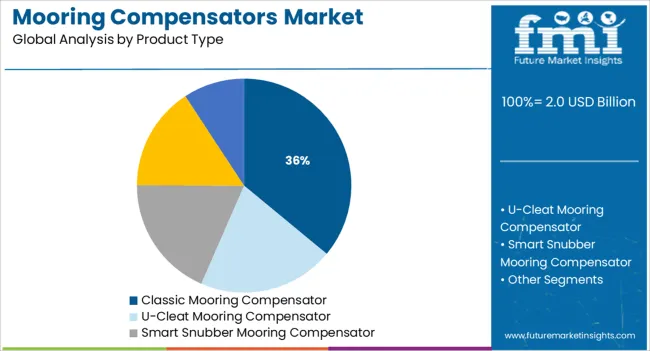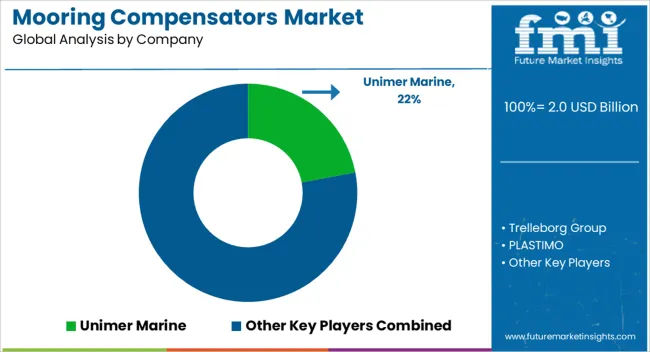The Mooring Compensators Market is estimated to be valued at USD 2.0 billion in 2025 and is projected to reach USD 2.7 billion by 2035, registering a compound annual growth rate (CAGR) of 3.2% over the forecast period.

| Metric | Value |
|---|---|
| Mooring Compensators Market Estimated Value in (2025 E) | USD 2.0 billion |
| Mooring Compensators Market Forecast Value in (2035 F) | USD 2.7 billion |
| Forecast CAGR (2025 to 2035) | 3.2% |
The mooring compensators market is undergoing steady expansion, supported by increasing demand for reliable anchoring systems in recreational boating, maritime logistics, and aquaculture. As environmental conditions grow more unpredictable and vessel activity intensifies in nearshore waters, there is a greater need for mooring solutions that can absorb shock loads and minimize structural stress.
Regulatory emphasis on maritime safety and evolving standards in marine equipment performance are influencing procurement preferences. Simultaneously, innovations in elastomer engineering and fatigue resistance are enhancing product lifespan and efficiency.
Investments in sustainable raw materials and modular production techniques are helping manufacturers meet durability standards while optimizing cost. With heightened focus on safe mooring in tidal zones, harbors, and floating docks, the market is poised to benefit from OEM partnerships and product customization aligned with vessel size, usage conditions, and regional compliance frameworks.
The market is segmented by Raw Material Type and Product Type and region. By Raw Material Type, the market is divided into Rubber Based and Polyurethane Based. In terms of Product Type, the market is classified into Classic Mooring Compensator, U-Cleat Mooring Compensator, Smart Snubber Mooring Compensator, Inline Mooring Compensator, and Others. Based on Raw Material Type, the market is segmented into Rubber Based and Polyurethane Based. Regionally, the market is classified into North America, Latin America, Western Europe, Eastern Europe, Balkan & Baltic Countries, Russia & Belarus, Central Asia, East Asia, South Asia & Pacific, and the Middle East & Africa.

Rubber-based compensators are anticipated to hold 57.0% of the market revenue share in 2025, making this raw material type the most dominant. This leadership is being driven by the high elasticity, shock absorption capacity, and weather resistance of engineered rubber compounds, which are essential for minimizing tension spikes on mooring lines.
Rubber materials are favored for their ability to perform under varying temperature and saline water conditions without degradation. Additionally, advancements in marine-grade rubber formulations have extended product longevity, making them more suitable for long-term anchorage applications.
The segment’s strength is further supported by the ease of molding complex geometries, enabling integration with a range of line sizes and mounting configurations. As marinas and vessel owners prioritize reliability and reduced maintenance, rubber-based mooring compensators continue to be adopted as the standard in both commercial and recreational use cases.

Classic mooring compensators are projected to account for 36.0% of total revenue in 2025, positioning them as the leading product type in the market. Their dominance is attributed to widespread familiarity, proven performance in varied marine conditions, and broad compatibility with conventional mooring lines.
These units are typically constructed using durable rubber elements and simple, robust designs that ensure consistent tension relief and extended lifecycle without complex maintenance. Preference for classic models is also reinforced by their affordability and ease of installation, which appeals to both professional mariners and individual boat owners.
As boating activity increases globally and vessel density grows in harbor zones, classic compensators are expected to remain the go-to solution for preventing shock load failures and reducing mooring system fatigue.
The ability to extend the compensator:
The mooring compensators can be varied by changing the number of times the line is wound around it, which means with the increasing number of turns the mooring compensator can be extended.
Easy to install:
The mooring compensators are easy to fit. These require no extra fittings. The locking elements are present at both ends and are vulcanized into the compensator.
The North America mooring compensators market is expected to be one of the most important markets during the forecast period. In 2024, the region held a market share of 28%.
One of the primary factors that are driving the market in North America is the high disposable income of end users, as a result of which people are indulging in a lot of fun activities, which include boating, fishing, etc.
Apart from that, the safety that is being provided by mooring compensators is almost unmatched, and because of this, a lot of manufacturers have started making use of these compensators in their boats.
The Europe mooring compensators market is expected to be the largest market during the forecast period. In 2024, the Europe market had a share of 31%.
Europe is mainly meant for its boat manufacturing companies which make use of advanced motors, machines, and other watercraft accessories. With the adoption of the latest technologies, the application of metal-based compensators has reduced because of the noise factor associated with these. So, metal-based compensators are gradually being replaced by rubber-based mooring compensators.
Currently, the mooring compensators market is mainly dominated by key players who have been serving this niche for a long time. They are making all the developments that would matter the most for the market.
However, there is not much happening in the start-up ecosystem of the mooring compensators market. But, being in a different niche, aspiring entrepreneurs can make the best use of the existing infrastructure and the government initiatives related to this niche.
The adoption of the latest technology in the mooring compensators market brings about a lot of opportunities to the current generation of wantrepreneurs as they are the ones who know how to make the best use of these technologies.
Apart from that, even if the entrepreneurs do not have enough resources to establish a start-up, the presence of angel investors and other kinds of investors would certainly help them raise enough funds.

The key players in the mooring compensators market are investing in the development of a virtual interactive explorer platform. These would make use of LNG transfer solutions and, at the same time, ensure that safety and sustainability factors are taken into consideration.
Apart from that, the key players are also investing in the process of mergers and acquisitions to improve their production capabilities and also to expand their presence.
Some of the recent developments in the mooring compensators market are:
| Report Attribute | Details |
|---|---|
| Growth Rate | CAGR of 3.2% from 2025 to 2035 |
| Base Year for Estimation | 2025 |
| Historical Data | 2020 to 2024 |
| Forecast Period | 2025 to 2035 |
| Quantitative Units | Revenue in USD Million and CAGR from 2025 to 2035 |
| Report Coverage | Revenue Forecast, Volume Forecast, Company Ranking, Competitive Landscape, Growth Factors, Trends, and Pricing Analysis |
| Segments Covered | Material, Product Type, Mooring Type, Region |
| Regions Covered | North America; Latin America; Asia Pacific; Middle East and Africa(MEA); Europe |
| Key Countries Profiled | The USA, Canada, Brazil, Argentina, Germany, The United Kingdom, France, Spain, Italy, Nordics, BENELUX, Australia & New Zealand, China, India, GCC Countries, South Africa |
| Key Companies Profiled | Unimer Marine; Trelleborg Group; PLASTIMO; Anchor Marine; Chain Ropes and Anchors; Boat Accessories Australia; Excel Controlinkage Pvt. Ltd. |
| Customization | Available Upon Request |
The global mooring compensators market is estimated to be valued at USD 2.0 billion in 2025.
The market size for the mooring compensators market is projected to reach USD 2.7 billion by 2035.
The mooring compensators market is expected to grow at a 3.2% CAGR between 2025 and 2035.
The key product types in mooring compensators market are rubber based and polyurethane based.
In terms of product type, classic mooring compensator segment to command 36.0% share in the mooring compensators market in 2025.






Full Research Suite comprises of:
Market outlook & trends analysis
Interviews & case studies
Strategic recommendations
Vendor profiles & capabilities analysis
5-year forecasts
8 regions and 60+ country-level data splits
Market segment data splits
12 months of continuous data updates
DELIVERED AS:
PDF EXCEL ONLINE
Mooring Bollards Market Trends – Growth, Demand & Forecast 2025-2035

Thank you!
You will receive an email from our Business Development Manager. Please be sure to check your SPAM/JUNK folder too.
Chat With
MaRIA